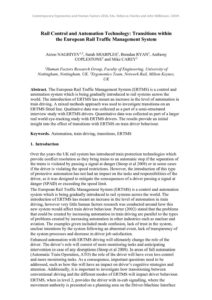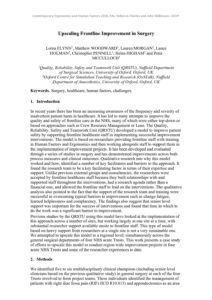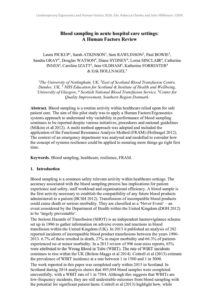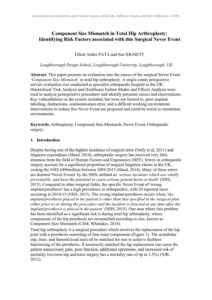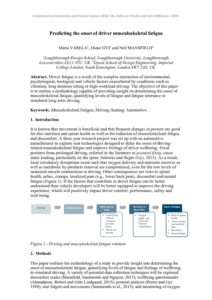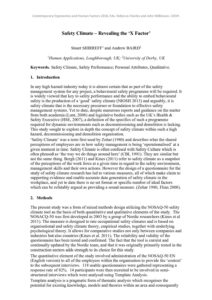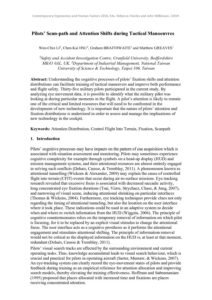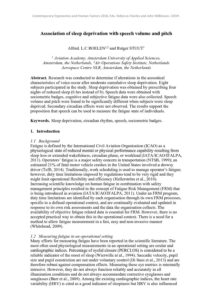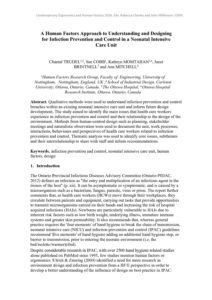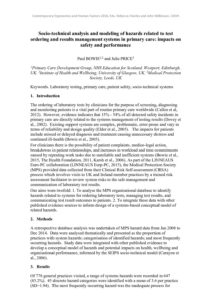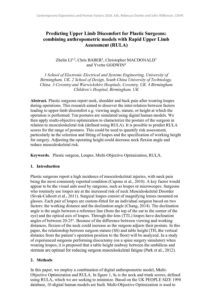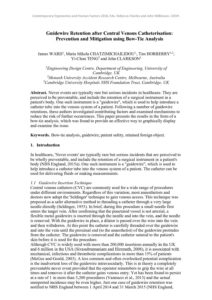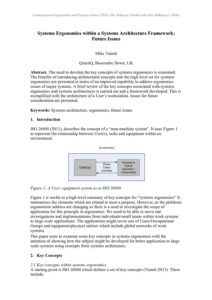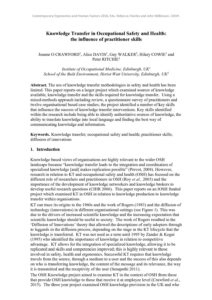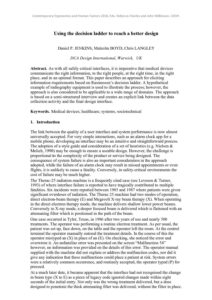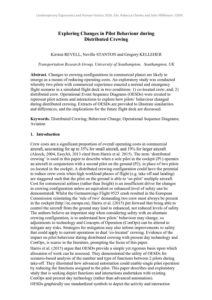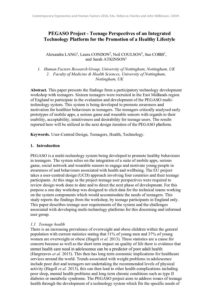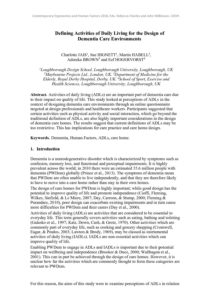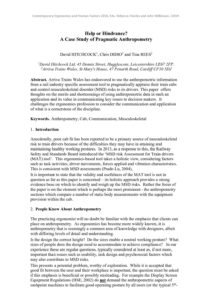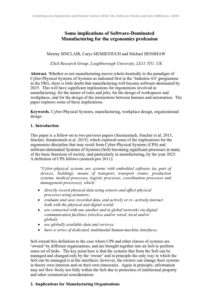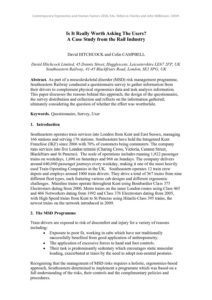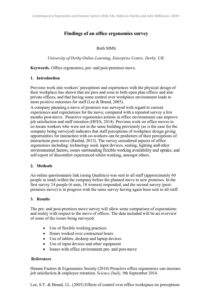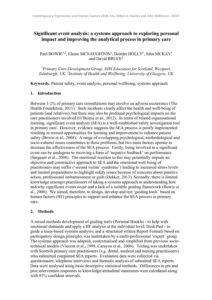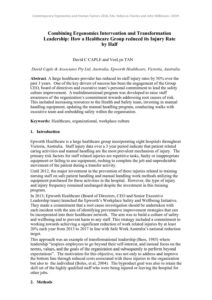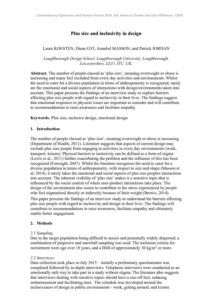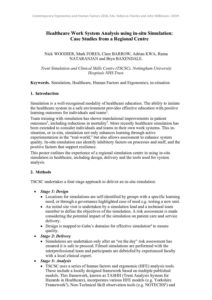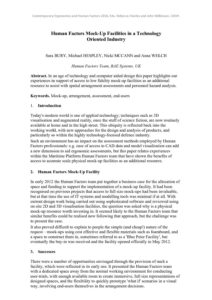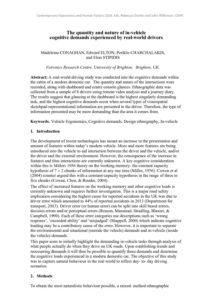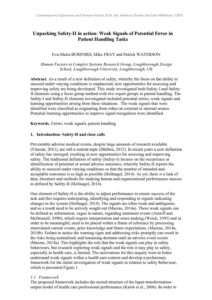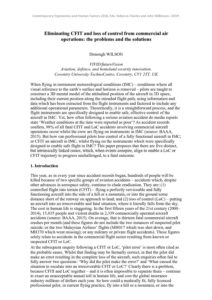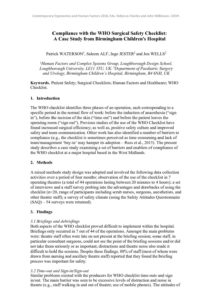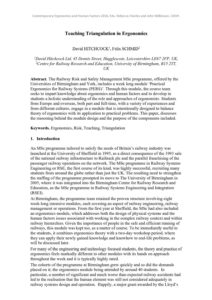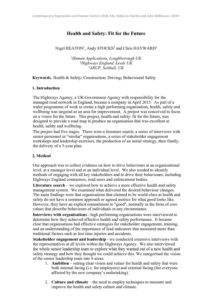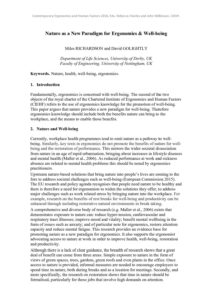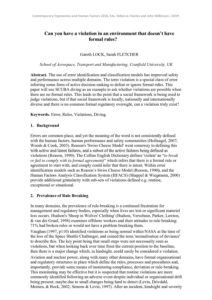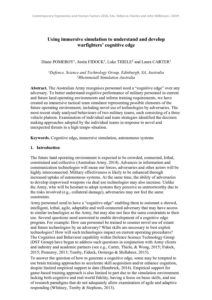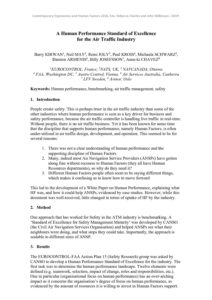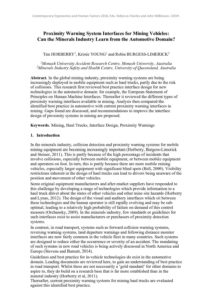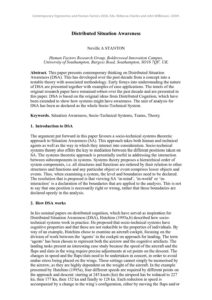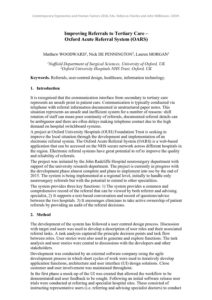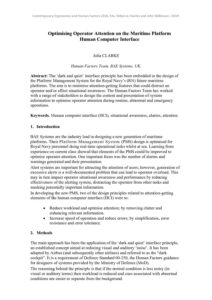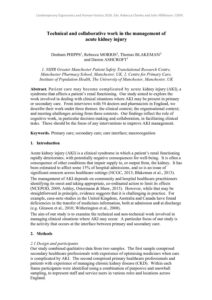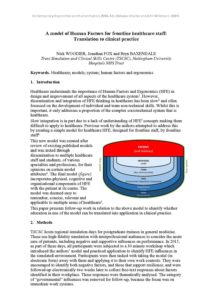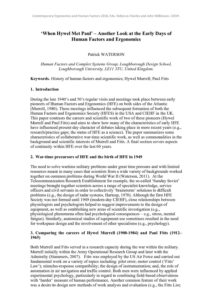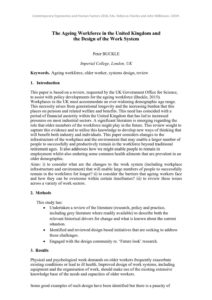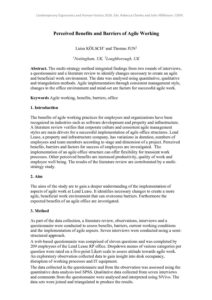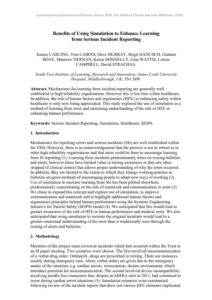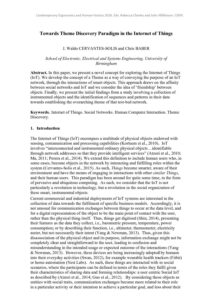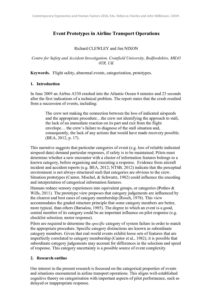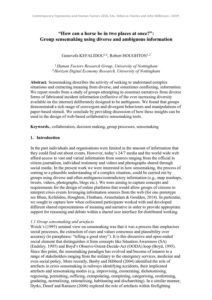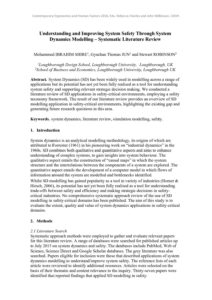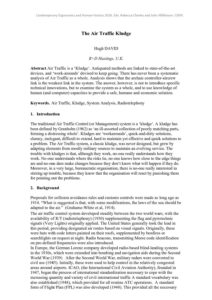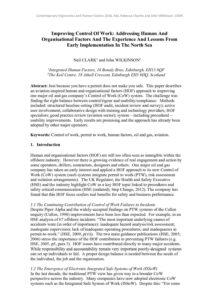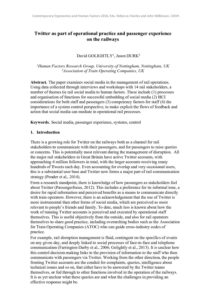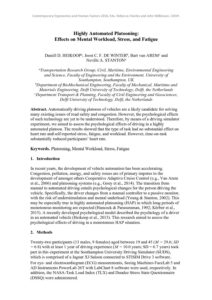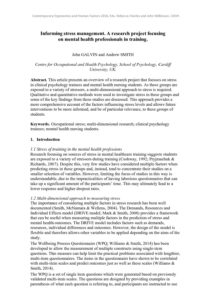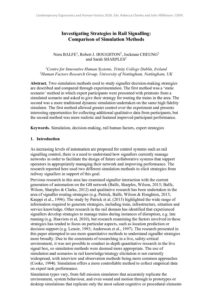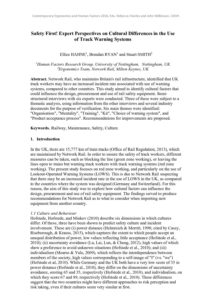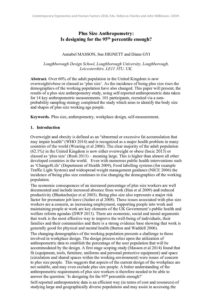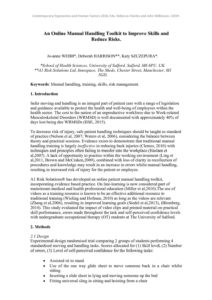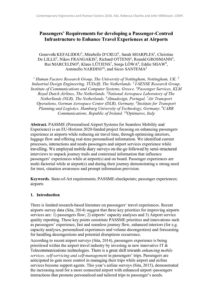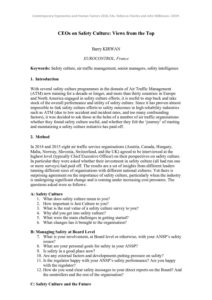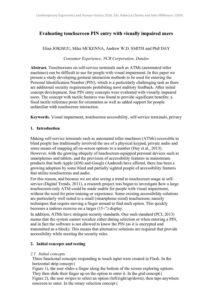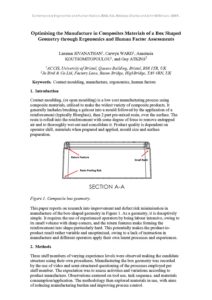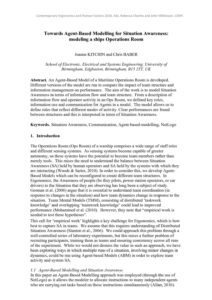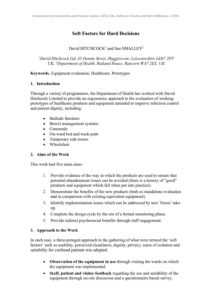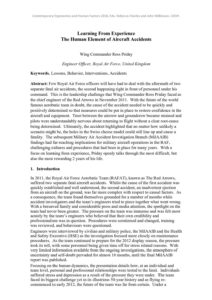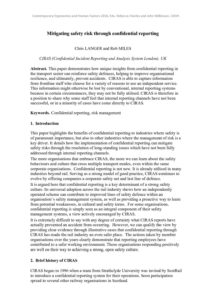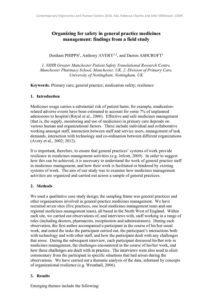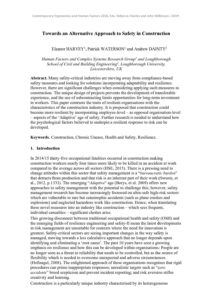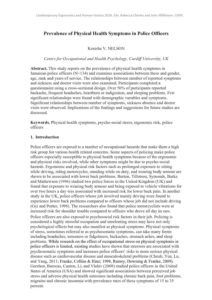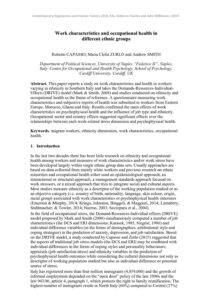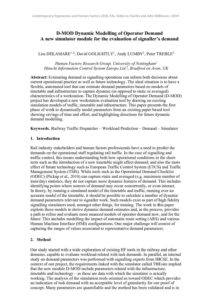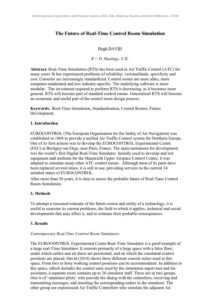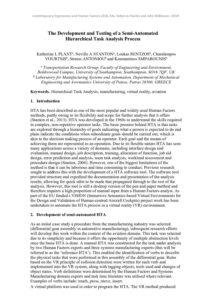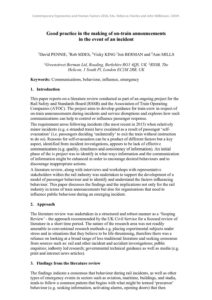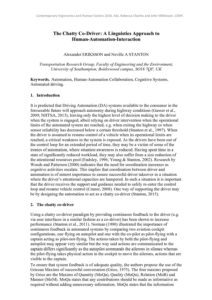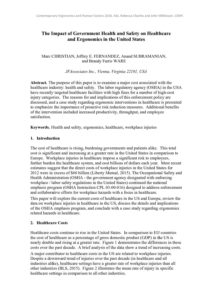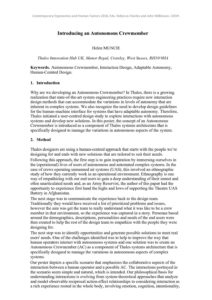Contemporary EHF 2016
Rail Control and Automation Technology: Transitions within the European Rail Traffic Management System
| Document | Author Arzoo NAGHIYEV, Sarah SHARPLES, Brendan RYAN, Anthony COPLESTONE and Mike CAREY |
| Abstract The European Rail Traffic Management System (ERTMS) is a control and automation system which is being gradually introduced to rail systems across the world. The introduction of ERTMS has meant an increase in the level of automation in train driving. A mixed methods approach was used to investigate transitions on an ERTMS fitted line. Qualitative data was collected as a part of a semi-structured interview study with ERTMS drivers. Quantitative data was collected as part of a larger real world eye-tracking study with ERTMS drivers. The results provide an initial insight into the effect of transitions with ERTMS on train driver behaviour. |
Upscaling Frontline Improvement in Surgery
| Document | Author Lorna FLYNN, Matthew WOODWARD, Lauren MORGAN, Lance HOLMAN, Christopher PENNELL, Helen HIGHAM and Peter MCCULLOCH |
| Abstract |
Blood sampling in acute hospital care settings: A Human Factors Review
| Document | Author Laura PICKUP, Sarah ATKINSON, Sam RAWLINSON, Paul BOWIE, Sandra GRAY, Douglas WATSON, Diane SYDNEY, Lorna SINCLAIR, Catherine INNES, Caroline IZATT, Jane OLDHAM, Katherine FORRESTER & Erik HOLLNAGEL |
| Abstract Blood sampling is a routine activity within healthcare relied upon for safe patient care. The aim of this pilot study was to apply a Human Factors/Ergonomics systems approach to understand why variability in performance of blood sampling continues to be reported despite various initiatives, procedures and national guidelines (Milkins et al 2012). A multi method approach was adopted and included the application of the Functional Resonance Analysis Method (FRAM) (Hollnagel 2012). The context of an emergency department was analysed and modelled to consider how the concept |
Component Size Mismatch in Total Hip Arthroplasty: Identifying Risk Factors associated with this Surgical Never Event
| Document | Author Elliott Attilio PATA and Sue HIGNETT |
| Abstract This paper presents an evaluation into the causes of the surgical Never Event ‘Component Size Mismatch’ in total hip arthroplasty. A single-centre prospective service evaluation was conducted at specialist orthopaedic hospital in the UK. Hierarchical Task Analysis and Healthcare Failure Modes and Effects Analysis were used to analyse perioperative procedures and identify potential causes and interventions. Key vulnerabilities in the system included, but were not limited to, poor implant labelling, distractions, communication error, and a difficult working environment. Interventions to reduce this Never Event are proposed and could be tested in simulation environments. |
Predicting the onset of driver musculoskeletal fatigue
| Document | Author Maria VARELA, Diane GYI and Neil MANSFIELD |
| Abstract Driver fatigue is a result of the complex interaction of environmental, psychological, biological and vehicle factors exacerbated by conditions such as vibration, long duration sitting or high-workload driving. The objective of this paper is to outline a methodology capable of providing insight on determining the onset of musculoskeletal fatigue, quantifying levels of fatigue and fatigue tolerance in simulated long-term driving. |
Safety Climate – Revealing the ‘X Factor’
| Document | Author Stuart SHIRREFF and Andrew BAIRD |
| Abstract |
Pilots’ Scan-path and Attention Shifts during Tactical Manoeuvres
| Document | Author Wen-Chin LI, Chen-Kai HSU, Graham BRAITHWAITE and Matthew GREAVES |
| Abstract Understanding the cognitive processes of pilots’ fixation shifts and attention distributions can facilitate training of tactical maneuvers and improve both performance and flight safety. Thirty-five military pilots participated in the current study. By analyzing eye movement data, it is possible to identify what the military pilot was looking at during particular moments in the flight. A pilot’s attention is likely to remain one of the critical and limited resources that will need to be confronted in the development of new technology. It is important that the nature of pilots’ attention and fixation distributions is understood in order to assess and manage the implications of new technology in the cockpit. |
Association of sleep deprivation with speech volume and pitch
| Document | Author Alfred. L.C ROELEN and Rutger STUUT |
| Abstract Research was conducted to determine if alterations in the acoustical characteristics of voice occur after moderate cumulative sleep deprivation. Eight subjects participated in the study. Sleep deprivation was obtained by prescribing four nights of reduced sleep (6 hrs instead of 8). Speech data were obtained with sociometric badges, cognitive and subjective fatigue data were also collected. Speech volume and pitch were found to be significantly different when subjects were sleep deprived. Secondary circadian effects were not observed. The results support the proposition that speech can be used to measure the fatigue state of individuals. |
A Human Factors Approach to Understanding and Designing for Infection Prevention and Control in a Neonatal Intensive Care Unit
| Document | Author Chantal TRUDEL, Sue COBB, Kathryn MOMTAHAN, Janet BRINTNELL and Ann MITCHELL |
| Abstract Qualitative methods were used to understand infection prevention and control breaches within an existing neonatal intensive care unit and inform future design development. The study aimed to identify the main issues that health care workers experience in infection prevention and control and their relationship to the design of the environment. Methods from human-centred design such as planning, stakeholder meetings and naturalistic observation were used to document the unit, work processes, interactions, behaviours and perspectives of health care workers related to infection prevention and control. Thematic analysis was used to identify core issues, subthemes and their interrelationship to share with staff and inform recommendations. |
Socio-technical analysis and modeling of hazards related to test ordering and results management systems in primary care: impacts on safety and performance
| Document | Author Paul BOWIE and Julie PRICE |
| Abstract |
Predicting Upper Limb Discomfort for Plastic Surgeons: combining anthropometric models with Rapid Upper Limb Assessment (RULA)
| Document | Author Zhelin LI, Chris BABER, Christopher MACDONALD and Yvette GODWIN |
| Abstract Plastic surgeons report neck, shoulder and back pain after wearing loupes during operations. This research aimed to discover the inter-relation between factors leading to upper-limb discomfort e.g. viewing angle, stature, or height at which the operation is performed. Ten postures are simulated using digital human models. We then apply multi-objective optimization to characterize the posture of the surgeon in relation to musculoskeletal risk (defined using RULA). It is possible to predict RULA scores for the range of postures. This could be used to quantify risk assessment, particularly in the selection and fitting of loupes and the specification of working height for surgery. Adjusting the operating height could decrease neck flexion angle and reduce musculoskeletal risk. |
Guidewire Retention after Central Venous Catheterisation: Prevention and Mitigation using Bow-Tie Analysis
| Document | Author James WARD, Maria Mikela CHATZIMICHAILIDOU, Tim HORBERRY, Yi-Chun TENG and John CLARKSON |
| Abstract Never events are typically rare but serious incidents in healthcare. They are perceived to be preventable, and include the retention of a surgical instrument in a patient's body. One such instrument is a "guidewire", which is used to help introduce a catheter tube into the venous system of a patient. Following a number of guidewire retentions, these authors investigated contributing factors and examined mechanisms to reduce the risk of further occurrences. This paper presents the results in the form of a bow-tie analysis, which was found to provide an effective way to graphically display and examine the issue. |
Systems Ergonomics within a Systems Architecture Framework: Future Issues
| Document | Author Mike Tainsh |
| Abstract The need to develop the key concepts of systems ergonomics is examined. The benefits of introducing architectural concepts into the high level set for systems ergonomics are presented in terms of an improved capability to address ergonomics issues of major systems. A brief review of the key concepts associated with systems ergonomics and systems architectures is carried out and a framework developed. This is exemplified with the architecture of a User’s workstation. Issues for future consideration are presented. |
Knowledge Transfer in Occupational Safety and Health: the influence of practitioner skills
| Document | Author Joanne O CRAWFORD, Alice DAVIS, Guy WALKER, Hilary COWIE and Peter RITCHIE |
| Abstract The use of knowledge transfer methodologies in safety and health has been limited. This paper reports on a larger project which examined sources of knowledge available, knowledge transfer and the skills required for knowledge transfer. Using a mixed-methods approach including review, a questionnaire survey of practitioners and twelve organisational based case studies; the project identified a number of key skills that influence the success of knowledge transfer interventions. Key skills identified within the research include being able to identify authoritative sources of knowledge, the ability to translate knowledge into local language and finding the best way of communicating knowledge and information. |
Using the decision ladder to reach a better design
| Document | Author Daniel P. JENKINS, Malcolm BOYD, Chris LANGLEY |
| Abstract As with all safely critical interfaces, it is imperative that medical devices communicate the right information, to the right people, at the right time, in the right place, and in an optimal format. This paper describes an approach for eliciting information requirements based on Rasmussen’s decision ladder. A hypothetical example of radiography equipment is used to illustrate the process; however, the approach is also considered to be applicable to a wide range of domains. The approach is based on a semi-structured interview and creates an explicit link between the data collection activity and the final design interface. |
Exploring Changes in Pilot Behaviour during Distributed Crewing
| Document | Author Kirsten REVELL, Neville STANTON and Gregory KELLEHER |
| Abstract Changes to crewing configurations in commercial planes are likely to emerge as a means of reducing operating costs. An exploratory study was conducted whereby two pilots with commercial experience enacted a normal and emergency flight scenario in a simulated flight deck in two conditions: 1) co-located crew, and; 2) distributed crew. Operational Event Sequence Diagrams (OESDs) were created to represent pilot actions and interactions to explore how pilots’ behaviour changed during distributed crewing. Extracts of OESDs are provided to illustrate similarities and differences, and the implications for the future flight deck are discussed. |
PEGASO Project – Teenage Perspectives of an Integrated Technology Platform for the Promotion of a Healthy Lifestyle
| Document | Author Alexandra LANG, Laura CONDON, Neil COULSON, Sue COBB, and Sarah ATKINSON |
| Abstract This paper presents the findings from a participatory technology development workshop with teenagers. Sixteen teenagers were recruited in the East Midlands region of England to participate in the evaluation and development of the PEGASO multi-technology system. This system is being developed to promote awareness and motivation for healthier behaviours in teenagers. The teenagers critically analysed early prototypes of mobile apps, a serious game and wearable sensors with regards to their usability, acceptability, intuitiveness and desirability for teenage users. The results reported here will be utilized in the next design iteration of the PEGASO platform. |
Defining Activities of Daily Living for the Design of Dementia Care Environments
| Document | Author Charlotte JAIS, Sue HIGNETT, Martin HABELL, Adonika BROWN and Eef HOGERVORST |
| Abstract Activities of daily living (ADLs) are an important part of dementia care due to their impact on quality of life. This study looked at perceptions of ADLs in the context of designing dementia care environments through an online questionnaire targeted at design professionals and healthcare workers. Participants suggested that certain activities such as physical activity and social interaction, which go beyond the traditional definition of ADLs, are also highly important considerations in the design of dementia care homes. The results suggest that current definitions of ADLs may be too restrictive. This has implications for care practice and care home design. |
Help or Hindrance? A Case Study of Pragmatic Anthropometry
| Document | Author David HITCHCOCK, Chris DIDIO and Tina REES |
| Abstract Arriva Trains Wales has endeavored to use the anthropometric information from a rail industry specific assessment tool to pragmatically appraise their train cabs and control musculoskeletal disorder (MSD) risks to its drivers. This paper offers thoughts on the merits and shortcomings of using anthropometric data in such an application and its value in communicating key issues to decision makers. It challenges the ergonomics profession to consider the communication and application of what is a cornerstone of the discipline. |
Some implications of Software – Dominated Manufacturing for the ergonomics profession
| Document | Author Murray SINCLAIR, Carys SIEMIENIUCH and Michael HENSHAW |
| Abstract Whether or not manufacturing moves whole-heartedly to the paradigm of Cyber-Physical Systems of Systems as indicated first in the ‘Industrie 4.0’ programme in the FRG, there is little doubt that manufacturing will become software-dominated by 2025. This will have significant implications for ergonomists involved in manufacturing: for the nature of roles and jobs, for the design of workspaces and workplaces, and for the design of the interactions between humans and automation. The paper explores some of these implications. |
Is It Really Worth Asking The Users? A Case Study from the Rail Industry
| Document | Author David HITCHCOCK and Colin CAMPBELL |
| Abstract As part of a musculoskeletal disorder (MSD) risk management programme, Southeastern Railway conducted a questionnaire survey to gather information from their drivers to complement physical ergonomics data and task analysis information. This paper discusses the reasons behind this approach, the design of the questionnaire, the survey distribution and collection and reflects on the information gathered; ultimately considering the question of whether the effort was worthwhile. |
Findings of an office ergonomics survey
| Document | Author Ruth SIMS |
| Abstract |
Assessment of Leadership and Management for Safety – where do we start?
| Document | Author Jonathan BERMAN, Shona WATSON and Michael ARGENT |
| Abstract |
Significant event analysis: a systems approach to exploring personal impact and improving the analytical process in primary care
| Document | Author Paul BOWIE, Elaine MCNAUGHTON, Deirdre HOLLY, John MCKAY and David BRUCE |
| Abstract |
Combining Ergonomics Intervention and Transformation Leadership: How a Healthcare Group reduced its Injury Rate by Half
| Document | Author David C CAPLE and VeeLyn TAN |
| Abstract A large healthcare provider has reduced its staff injury rates by 50% over the past 3 years. One of the key drivers of success has been the engagement of the Group CEO, board of directives and executive team’s personal commitment to lead the safety culture improvement. A multidimensional program was developed to raise staff awareness of the organization’s commitment towards addressing root causes of risk. This included increasing resources to the Health and Safety team, investing in manual handling equipment, updating the manual handling program, conducting walks with executive team and embedding safety within the organisation. |
Plus size and inclusivity in design
| Document | Author Laura KOESTEN, Diane GYI, Annabel MASSON, and Patrick JORDAN |
| Abstract The number of people classed as ‘plus size’, meaning overweight or obese is increasing and many feel excluded from every day activities and environments. Whilst the need to cater for a diverse population in terms of anthropometry is recognized, rarely are the emotional and social aspects of interactions with design/environments taken into account. This paper presents the findings of an interview study to explore barriers affecting plus size people with regard to inclusivity in their lives. The findings suggest that emotional responses to physical issues are important to consider and will contribute to recommendations to raise awareness and facilitate empathy. |
Healthcare Work System Analysis using in-situ Simulation: Case Studies from a Regional Centre
| Document | Author Nick WOODIER, Mark FORES, Clare BARROW, Adrian KWA, Rama NATARANJAN and Bryn BAXENDALE |
| Abstract |
Human Factors Mock-Up Facilities in a Technology Oriented Industry
| Document | Author Sara BURY, Michael HESPLEY, Nicki MCCANN and Anna WELCH |
| Abstract In an age of technology and computer aided design this paper highlights our experiences in support of access to low fidelity mock-up facilities as an additional resource to assist with spatial arrangement assessments and personnel hazard analysis. |
The quantity and nature of in-vehicle cognitive demands experienced by real-world drivers
| Document | Author Madeleine CONAGHAN, Edward ELTON, Periklis CHARCHALAKIS, and Elias STIPIDIS |
| Abstract A real-world driving study was conducted into the cognitive demands within the cabin of a modern domestic car. The quantity and nature of the interactions were recorded, along with dashboard and centre console glances. Ethnographic data was collected from a sample of 8 drivers using remote video analysis and a journey diary. The results suggest that glancing at the dashboard is the highest singularly demanding task, and the highest cognitive demands occur when several types of visuospatial sketchpad representational information are presented to the driver. Therefore, the type of information presented may be more demanding than the area it comes from. |
Unpacking Safety-II in action: Weak Signals of Potential Error in Patient Handling Tasks
| Document | Author Eva-Maria BURFORD, Mike FRAY and Patrick WATERSON |
| Abstract As a result of a new definition of safety, whereby the focus on the ability to succeed under varying conditions is emphasised, new opportunities for assessing and improving safety are being developed. This study investigated both Safety-I and Safety-II elements using a focus group method with two expert groups in patient handling. The Safety-I and Safety-II elements investigated included potential errors, weak signals and learning opportunities arising from these situations. The weak signals that were identified were classified as originating from either an external or internal source. Potential learning opportunities to improve signal recognition were identified. |
Eliminating CFIT and loss of control from commercial air operations: the problems and the solutions
| Document | Author Donough WILSON |
| Abstract When flying in instrument meteorological conditions (IMC) – conditions where all visual reference to the earth’s surface and horizon is removed – pilots are taught to construct a 3D mental model of the attitudinal position of the aircraft in 3D space, including their current position along the intended flight path, using information and data which has been extracted from the flight instruments and factored to include any additional operational parameters. Theoretically, it is a straightforward process, and the flight instruments are specifically designed to enable safe, effective control of the aircraft in IMC. Yet, how often following a serious aviation accident do media reports state ‘Weather conditions at the time were reported as poor’? As accident records confirm, 98% of all fatal CFIT and LoC accidents involving commercial aircraft operations occur whilst the crew are flying on instruments in IMC (source: BAAA, 2015). But how can professional pilots lose control of a fully functional aircraft in IMC; or CFIT an aircraft in IMC, whilst flying on the instruments which were specifically designed to enable safe flight in IMC? This paper proposes that there are five distinct, but intrinsically linked issues, which, when events conspire, align to enable a LoC or CFIT trajectory to progress unchallenged, to a fatal outcome. |
Compliance with the WHO Surgical Safety Checklist: A Case Study from Birmingham Children’s Hospital
| Document | Author Patrick WATERSON, Saleem ALI, Ingo JESTER and Jon WELLS |
| Abstract |
Teaching Triangulation in Ergonomics
| Document | Author David HITCHCOCK, Felix SCHMID |
| Abstract The Railway Risk and Safety Management MSc programme, offered by the Universities of Birmingham and York, includes a week long module ‘Practical Ergonomics for Railway Systems (PERS)’. Through this module, the course team seeks to impart knowledge about ergonomics and human factors and to develop in students a holistic understanding of the role and approaches of ergonomists. Students from Europe and overseas, both part and full-time, with a variety of experiences and from different cultures, engage in a module that is intentionally designed to balance theory of ergonomics with its application to practical problems. This paper, discusses the reasoning behind the module design and the purpose of the components included. |
Health and Safety: Fit for the Future
| Document | Author Nigel HEATON, Andy STOCKS and Chris HAYWARD |
| Abstract |
Nature as a New Paradigm for Ergonomics and Well-being
| Document | Author Miles RICHARDSON and David GOLIGHTLY |
| Abstract |
Can you have a violation in an environment that doesn’t have formal rules?
| Document | Author Gareth LOCK, Sarah FLETCHER |
| Abstract The use of error identification and classification models has improved safety and performance across multiple domains. The term violation is a special class of error inferring some form of active decision making to defeat or ignore formal rules. This paper will use SCUBA diving as an example to ask whether violations are possible when there are no formal rules. This leads to the point that a social framework is being used to judge violations, but if that social framework is locally, nationally and internationally diverse and there is no common formal regulatory oversight, can a violation truly exist? |
Using immersive simulation to understand and develop warfighters’ cognitive edge
| Document | Author Diane POMEROY, Justin FIDOCK, Luke THIELE and Laura CARTER |
| Abstract The Australian Army recognises personnel need a “cognitive edge” over any adversary. To better understand cognitive performance of military personnel in current and future land operating environments and inform training requirements, we have created an immersive tactical team simulator representing possible elements of the future operating environment, including novel use of technologies by adversaries. The most recent study analysed behaviours of two military teams, each consisting of a three vehicle platoon. Examination of individual and team strategies identified the decision making approaches adopted by the individual teams in response to novel and unexpected threats in a high tempo situation. |
A Human Performance Standard of Excellence for the Air Traffic Industry
| Document | Author Barry KIRWAN, Neil MAY, Remi JOLY, Paul KROIS, Michaela SCHWARZ, Damien ARMENIS, Billy JOSEFSSON, Anne-ki CHAVEZ |
| Abstract |
Proximity Warning System Interfaces for Mining Vehicles: Can the Minerals Industry Learn from the Automotive Domain?
| Document | Author Tim HORBERRY, Kristie YOUNG and Robin BURGESS-LIMERICK |
| Abstract In the global mining industry, proximity warning systems are being increasingly deployed in mobile equipment such as haul trucks, partly due to the risk of collisions. This research first reviewed best practice interface design for new technologies in the automotive domain: for example, the European Statement of Principles on Human Machine Interfaces. Thereafter it reviewed the different types of proximity warning interfaces available in mining. Analysis then compared the identified best practice in automotive with current proximity warning interfaces in mining. Gaps found are discussed, and recommendations to improve the interface design of proximity systems in mining are proposed. |
Distributed Situation Awareness
| Document | Author Neville A STANTON |
| Abstract This paper presents contemporary thinking on Distributed Situation Awareness (DSA). This has developed over the past decade from a concept into a testable theory with associated methodology. Early forays into understanding the nature of DSA are presented together with examples of case applications. The tenets of the original research paper have remained robust over the past decade and are presented in this paper. DSA is based on the original ideas from Distributed Cognition, which have been extended to show how systems might have awareness. The unit of analysis for DSA has been as declared as the whole Socio-Technical System. |
Improving Referrals to Tertiary Care – Oxford Acute Referral System (OARS)
| Document | Author Matthew WOODWARD, Nick DE PENNINGTON, Lauren MORGAN |
| Abstract |
Optimising Operator Attention on the Maritime Platform Human Computer Interface
| Document | Author Julia CLARKE |
| Abstract The ‘dark and quiet’ interface principle has been embedded in the design of the Platform Management System for the Royal Navy’s (RN) future maritime platforms. The aim is to minimise attention-getting features that could distract an operator and/or affect situational awareness. The Human Factors Team has worked with a range of stakeholders to design the content and presentation of system information to optimise operator attention during routine, abnormal and emergency operations. |
Technical and collaborative work in the management of acute kidney injury
| Document | Author Denham PHIPPS, Rebecca MORRIS, Thomas BLAKEMAN and Darren ASHCROFT |
| Abstract Patient care may become complicated by acute kidney injury (AKI), a syndrome that affects a patient’s renal functioning. Our study aimed to explore the work involved in dealing with clinical situations where AKI may be present in primary or secondary care. From interviews with 54 doctors and pharmacists in England, we describe their work under three themes: the clinical context; the organisational context; and meeting challenges arising from these contexts. Our findings reflect the role of cognitive work, in particular decision making and collaboration, in facilitating clinical tasks. These should be the focus of any interventions to improve AKI management. |
A model of Human Factors for frontline healthcare staff: Translation to clinical practice
| Document | Author Nick WOODIER, Jonathan FOX and Bryn BAXENDALE |
| Abstract |
‘When Hywel Met Paul’ – Another Look at the Early Days of Human Factors and Ergonomics
| Document | Author Patrick WATERSON |
| Abstract |
The Ageing Workforce in the United Kingdom and the Design of the Work System
| Document | Author Peter BUCKLE |
| Abstract |
Perceived Benefits and Barriers of Agile Working
| Document | Author Luisa KÖLSCH and Thomas JUN |
| Abstract The multi-strategy method integrated findings from two rounds of interviews, a questionnaire and a literature review to identify changes necessary to create an agile and beneficial work environment. The data was analysed using quantitative, qualitative and triangulation methods. Agile implementation through consistent management style, changes to the office environment and mind-set are factors for successful agile work. |
Benefits of Using Simulation to Enhance Learning from Serious Incident Reporting
| Document | Author Joanne CARLING, Tom CAIRNS, Dave MURRAY, Birgit HANUSCH, Graham BONE, Maureen TIERNAN, Karen DONNELLY, Gina WATTIS, Louise CAMPBELL, David STRACHAN |
| Abstract Mechanisms for learning from incident reporting are generally well established in high reliability organisations. However this is less true within healthcare. In addition, the role of human factors and ergonomics (HFE) in enhancing safety within healthcare is only now being appreciated. This study explored the use of simulation as a method of learning from error and increasing understanding of the role of HFE in enhancing human performance. |
Towards Theme Discovery Paradigm in the Internet of Things
| Document | Author J. Waldo CERVANTES-SOLIS and Chris BABER |
| Abstract In this paper, we present a novel concept for exploring the Internet of Things (IoT). We develop the concept of a Theme as a way of conveying the purpose of an IoT network, through the interactions of smart objects. This approach draws on the affinity between social networks and IoT and we consider the idea of ‘friendship’ between objects. Finally, we present the initial findings from a study involving a collection of instrumented objects and the identification of sequences and patterns in their data towards establishing the overarching theme of that test-bed network. |
Event Prototypes in Airline Transport Operations
| Document | Author Richard CLEWLEY and Jim NIXON |
| Abstract |
“How can a horse be in two places at once?”: Group sensemaking using diverse and ambiguous information
| Document | Author Genovefa KEFALIDOU, Robert HOUGHTON |
| Abstract Sensemaking describes the activity of seeking to understand complex situations and extracting meaning from diverse, and sometimes conflicting, information. We report results from a study of groups attempting to construct narratives from diverse forms of fabricated incident information (reflective of the ever increasing diversity available on the internet) deliberately designed to be ambiguous. We found that groups demonstrated a rich range of convergent and divergent behaviours and manipulations of paper-based stimuli. We conclude by providing discussion of how these insights can be used in the design of web-based collaborative sensemaking tools. |
Understanding and Improving System Safety Through System Dynamics Modelling – Systematic Literature Review
| Document | Author Mohammed IBRAHIM SHIRE, Gyuchan Thomas JUN and Stewart ROBINSON |
| Abstract System Dynamics (SD) has been widely used in modelling across a range of applications but its potential has not yet been fully realised as a tool for understanding system safety and supporting relevant strategic decision making. We conducted a literature review of SD applications in safety-critical environments, employing a safety taxonomy framework. The result of our literature review provides an overview of SD modelling application in safety-critical environments, highlighting the existing gap and generating future research questions in this area. |
The Air Traffic Kludge
| Document | Author Hugh DAVID |
| Abstract Air Traffic is a ‘Kludge’. Antiquated methods are linked to state-of-the-art devices, and ‘work-arounds’ devised to keep going. There has never been a systematic analysis of Air Traffic as a whole. Analysis shows that the archaic controller-aircrew link is the weakest link in the system. The answer, however, is not to introduce specific technical innovations, but to examine the system as a whole, and to use knowledge of human (and computer) capacities to provide a safe, humane and economic solution. |
Improving Control Of Work: Addressing Human And Organisational Factors And The Experience And Lessons From Early Implementation In The North Sea
| Document | Author Neil CLARK and John WILKINSON |
| Abstract Just because you have a permit does not make you safe. This paper describes an aviation-inspired human and organisational factors (HOF) approach to improving one major oil and gas company’s Control of Work (CoW) system. The challenge was finding the right balance between control/rigour and usability/compliance. Methods included: structured baseline setting (HOF audit, incident review and survey); active user involvement; collaborative design with training and technology providers, HOF specialists; good practice review (aviation sector); system – including procedural – usability improvements. Early results are promising and the approach has already been adopted by other major operators. |
Twitter as part of operational practice and passenger experience on the railways
| Document | Author David GOLIGHTLY, Jason DURK |
| Abstract The paper examines social media in the management of rail operations. Using data collected through interviews and workshops with 14 rail stakeholders, a number of themes tie rail social media to human factors. These include (1) processes and organisation of functions for successful embedding of social media (2) HCI considerations for both staff and passengers (3) competency factors for staff (4) the importance of a system control perspective, to make explicit the flows of feedback and action that social media can mediate in operational rail processes. |
Highly Automated Platooning: Effects on Mental Workload, Stress, and Fatigue
| Document | Author Daniël D. HEIKOOP, Joost C. F. DE WINTER, Bart van AREM and Neville A. STANTON |
| Abstract Automatically driving platoons of vehicles are a likely candidate for solving many existing issues of road safety and congestion. However, the psychological effects of such technology are yet to be understood. Therefore, by means of a driving simulator experiment, we aimed to assess the psychological effects of driving in a highly automated platoon. The results showed that the type of task had no substantial effect on heart rate and self-reported stress, fatigue, and workload. However, time-on-task substantially reduced participants’ heart rate. |
Informing stress management. A research project focusing on mental health professionals in training.
| Document | Author John GALVIN and Andrew SMITH |
| Abstract This article presents an overview of a research project that focuses on stress in clinical psychology trainees and mental health nursing students. As these groups are exposed to a variety of stressors, a multi-dimensional approach to stress is required. Qualitative and quantitative methods were used to investigate stress in these groups and some of the key findings from these studies are discussed. This approach provides a more comprehensive account of the factors influencing stress levels and allows future interventions to be more informed, and be of particular relevance, to these groups of students. |
Investigating Strategies in Rail Signalling: Comparison of Simulation Methods
| Document | Author Nora BALFE, Robert J. HOUGHTON, Jockman CHEUNG and Sarah SHARPLES |
| Abstract Two simulation methods used to study signaller decision-making strategies are described and compared through experimentation. The first method was a ‘static scenario’ method in which expert participants were presented with printouts from a simulated scenario and asked to give their strategy for routing the trains in the area. The second was a more traditional dynamic simulation undertaken on the same high fidelity simulator. The first method allowed greater control over the experiment and presents interesting opportunities for collecting additional qualitative data from participants, but the second method was more realistic and featured improved participant performance. |
Safety First! Expert Perspectives on Cultural Differences in the Use of Track Warning Systems
| Document | Author Ellice HAHNE, Brendan RYAN and Stuart SMITH |
| Abstract Network Rail, who maintains Britain's rail infrastructure, identified that UK track workers may have an increased incident rate associated with use of warning systems, compared to other countries. This study aimed to identify cultural factors that could influence the design, procurement and use of rail safety equipment. Semi-structured interviews with six experts were conducted. Three of these were subject to a thematic analysis, using information from the other interviews and several industry documents for the purpose of verification. Six main themes were identified: "Organisation", "Mentality", "Training", "Kit", "Choice of warning system", and "Product acceptance process". Recommendations for improvements are proposed. |
Plus Size Anthropometry: Is designing for the 95th percentile enough?
| Document | Author Annabel MASSON, Sue HIGNETT and Diane GYI |
| Abstract Over 60% of the adult population in the United Kingdom is now overweight/obese or classed as ‘plus size’. As the incidence of being plus size rises the demographics of the working population have also changed. This paper will present, the results of a plus size anthropometry study, using self-reported anthropometric data taken for 14 key anthropometric measurements. 101 participants, recruited via a non-probability sampling strategy completed the study which aims to identify the body size and shapes of plus size working age people. |
An Online Manual Handling Toolkit to Improve Skills and Reduce Risks
| Document | Author Jo-anne WEBB, Deborah HARRISON, Katy SZCZEPURA |
| Abstract |
Passengers’ Requirements for developing a Passenger-Centred Infrastructure to Enhance Travel Experiences at Airports
| Document | Author Genovefa KEFALIDOU1, Mirabelle D’CRUZ1, Sarah SHARPLES, Christine De LILLE, Nikos FRANGAKIS, Richard OTTENS, Ronald GROSMANN, Rui MARCELINO, Klaus LÜTJENS, Sonja LÖWA, Eddie SHAW, Antonello NARDINI, and Sicco SANTEMA |
| Abstract PASSME (Personalised Airport Systems for Seamless Mobility and Experience) is an EU-Horizon 2020-funded project focusing on enhancing passengers experience at airports while reducing air travel time, through optimising interiors, luggage flow and offering real-time personalised information. We identified current processes, interactions and needs passengers and airport services experience while travelling. We employed mobile diary surveys on-the-go followed by semi-structured interviews to unpack journey trails and contextual information that influence passengers’ experiences while at airport(s) and on board. Passenger experiences are multi-factorial while at airport(s) and during their journey demonstrating a strong need for trust, situation awareness and prompt information provision. |
CEOs on Safety Culture: Views from the Top
| Document | Author Barry KIRWAN |
| Abstract |
Evaluating touchscreen PIN entry with visually impaired users
| Document | Author Elina JOKISUU, Mike MCKENNA, Andrew W.D. SMITH and Phil DAY |
| Abstract Touchscreens on self-service terminals such as ATMs (automated teller machines) can be difficult to use for people with visual impairment. In this paper we present a study developing gestural interaction methods to be used for entering the Personal Identification Number (PIN), which is a particularly challenging task as there are additional security requirements prohibiting most auditory feedback. After initial concept development, four PIN entry concepts were evaluated with visually impaired users. The concept with tactile features was found to provide significant benefits: a fixed tactile reference point for orientation as well as added support for people unfamiliar with touchscreen interaction. |
Optimising the Manufacture in Composites Materials of a Box Shaped Geometry through Ergonomics and Human Factor Assessments
| Document | Author Laxman SIVANATHAN, Carwyn WARD, Anastasia KOUTSOMITOPOULOU, and Guy ATKINS |
| Abstract |
Towards Agent-Based Modelling for Situation Awareness: modeling a ships Operations Room
| Document | Author Joanne KITCHIN and Chris BABER |
| Abstract An Agent-Based Model of a Maritime Operations Room is developed. Different versions of the model are run to compare the impact of team structure and information management on performance. The aim of the work is to model Situation Awareness in terms of information flow and team structure. From a description of information flow and operator activity in an Ops Room, we defined key roles, information use and communication for Agents in a model. The model allows us to define rules that reflect different modes of activity. Clear performances are found between structures and this is interpreted in terms of Situation Awareness. |
Soft Factors for Hard Decisions
| Document | Author David HITCHCOCK and Sue SMALLEY |
| Abstract |
Learning From Experience: The Human Element of Aircraft Accidents
| Document | Author Wing Commander Ross Priday |
| Abstract Few Royal Air Force officers will have had to deal with the aftermath of two separate fatal air accidents, the second happening right in front of personnel under his command. This is the leadership challenge that Wing Commander Ross Priday faced as the chief engineer of the Red Arrows in November 2011. With the future of the world famous aerobatic team in doubt, the cause of the accident needed to be quickly and positively determined so that measures could be put in place to restore confidence in the aircraft and equipment. Trust between the aircrew and groundcrew became strained and pilots were understandably nervous about returning to flight without a clear root-cause being determined. Ultimately, the accident highlighted that no matter how unlikely a scenario might be, the holes in the Swiss cheese model could still line up and cause a fatality. The subsequent Military Air Accident Investigation Branch (MilAAIB) findings had far-reaching implications for military aircraft operations in the RAF, challenging cultures and procedures that had been in place for many years. With a focus on learning from experience, Priday openly talks through the most difficult, but also the most rewarding 2 years of his life. |
Mitigating safety risk through confidential reporting
| Document | Author Chris LANGER and Rob MILES |
| Abstract This paper demonstrates how unique insights from confidential reporting in the transport sector can reinforce safety defences, helping to improve organisational resilience, and ultimately, prevent accidents. CIRAS is able to capture information from frontline staff who choose for a variety of reasons to use an independent service. This information might otherwise be lost by conventional, internal reporting systems because in certain circumstances, they may not be fully utilised. CIRAS is therefore in a position to share why some staff feel that internal reporting channels have not been successful, or in a minority of cases have come directly to CIRAS. |
Organizing for safety in general practice medicines management: findings from a field study
| Document | Author Denham PHIPPS, Anthony AVERY, and Darren ASHCROFT |
| Abstract |
Towards an Alternative Approach to Safety in Construction
| Document | Author Eleanor HARVEY, Patrick WATERSON and Andrew DAINTY |
| Abstract Many safety-critical industries are moving away from compliance-based safety measures and looking for solutions incorporating adaptability and resilience. However, there are significant challenges when considering applying such measures to construction. The unique design of projects prevents the development of transferable experience, and the use of subcontracting limits opportunities for long-term investment in workers. This paper contrasts the traits of resilient organisations with the characteristics of the construction industry. It is proposed that construction could become more resilient by incorporating employee-level – as opposed organisation-level – aspects of the ‘Adaptive’ age of safety. Further research is needed to understand how the psychological factors believed to underpin a resilient response to risk can be developed. |
Prevalence of Physical Health Symptoms in Police Officers
| Document | Author Kenisha V. NELSON |
| Abstract This study reports on the prevalence of physical health symptoms in Jamaican police officers (N=134) and examines associations between these and gender, age, rank and years of service. The relationships between number of reported symptoms and sickness and doctor visits were also examined. Participants completed a questionnaire using a cross-sectional design. Over 50% of participants reported backache, frequent headaches, heartburn or indigestion, and sleeping problems. Few significant relationships were found with demographic variables and symptoms. Significant relationships between number of symptoms, sickness absence and doctor visits were observed. Implications of the findings and suggestions for future studies are discussed. |
Work characteristics and occupational health in different ethnic groups
| Document | Author Roberto CAPASSO, Maria Clelia ZURLO and Andrew SMITH |
| Abstract This paper reports a study on work characteristics and health in workers varying in ethnicity in Southern Italy and takes the Demands-Resources-Individual-Effects (DRIVE) model (Mark & Smith, 2008) and studies conducted on ethnicity and occupational health as the frame of reference. A questionnaire measuring work characteristics and subjective reports of health was submitted to workers from Eastern Europe, Morocco, Ghana and Italy. Results confirmed the main effects of work characteristics on psychophysical health and the influence of job type and ethnicity. Occupational sector and country effects suggested significant effects over the relationships between each work-related stress dimension and psychophysical health. |
D-MOD Dynamic Modelling of Operator Demand – A new simulator module for the evaluation of signaller’s demand
| Document | Author Lise DELAMARE, David GOLIGHTLY, Andy LUMBY, Peter TREBLE |
| Abstract Estimating demand in signalling operations can inform both decisions about current operational practice as well as future technology. The ideal situation is to have a flexible, automated tool that can estimate demand parameters based on models of timetable and infrastructure to capture dynamic (as opposed to static or averaged) characteristics of a workstation. The Dynamic Modelling of Operator Demand (D-MOD) project has developed a new workstation evaluation tool by drawing on existing simulation models of traffic, timetable and infrastructure. This paper presents the first phase of work to dynamically model parameters from an existing paper based tool showing savings of time and effort, and highlighting directions for future dynamic demand modelling. |
The Future of Real-Time Control Room Simulation
| Document | Author Hugh DAVID |
| Abstract Real-Time Simulation (RTS) has been used in Air Traffic Control (ATC) for many years. It has experienced problems of reliability, verisimilitude, specificity and cost. Consoles are increasingly standardized. Control rooms are more alike, more computer-moderated and less industry-specific. The underlying software is more modular. The investment required to perform RTS is decreasing, as it becomes more general. RTS will become part of standard control rooms. Generalized RTS will become an economic and useful part of the control room design process. |
The Development and Testing of a Semi-Automated Hierarchical Task Analysis Process
| Document | Author Katherine L PLANT, Neville A STANTON, Loukas RENTZOS, Charalampos VOURTSIS, Stratos ANTONIOU and Konstantinos SMPAROUNIS |
| Abstract |
Good practice in the making of on-train announcements in the event of an incident
| Document | Author David PENNIE, Rob SIDES, Vicky KING, Jon BERMAN and Ann MILLS |
| Abstract |
The Chatty Co-Driver: A Linguistics Approach to Human-Automation-Interaction
| Document | Author Alexander ERIKSSON and Neville A STANTON |
| Abstract |
The Impact of Government Health and Safety on Healthcare and Ergonomics in the United States
| Document | Author Marc CHRISTIAN, Jeffrey E. FERNANDEZ, Anand SUBRAMANIAN, and Brandy Farris WARE |
| Abstract The purpose of this paper is to examine a major cost associated with the healthcare industry: health and safety. The labor regulatory agency (OSHA) in the USA have recently targeted healthcare facilities with high fines for a number of high-cost injury categories. The reasons for and implications of this enforcement policy are discussed, and a case study regarding ergonomic interventions in healthcare is presented to emphasize the importance of proactive risk reduction measures. Additional benefits of the intervention included increased productivity, throughput, and employee satisfaction. |
Introducing an Autonomous Crewmember
| Document | Author Helen MUNCIE |
| Abstract |

